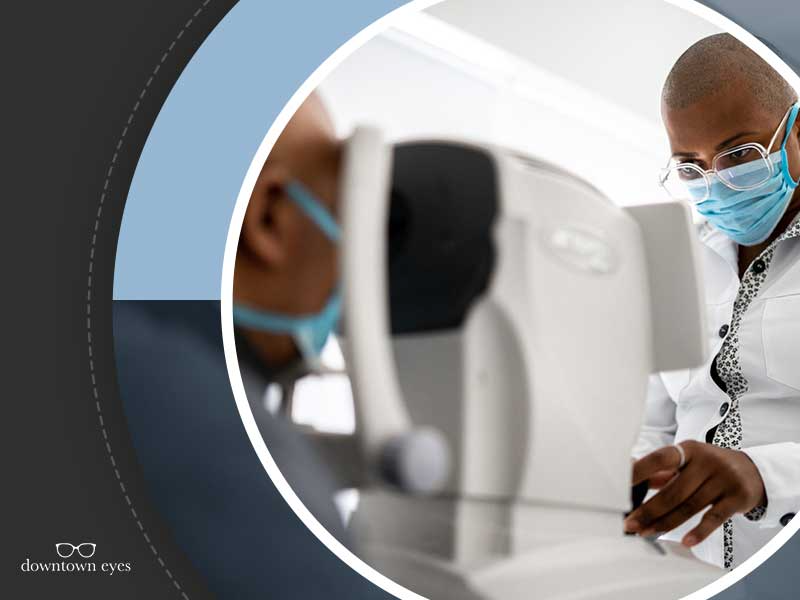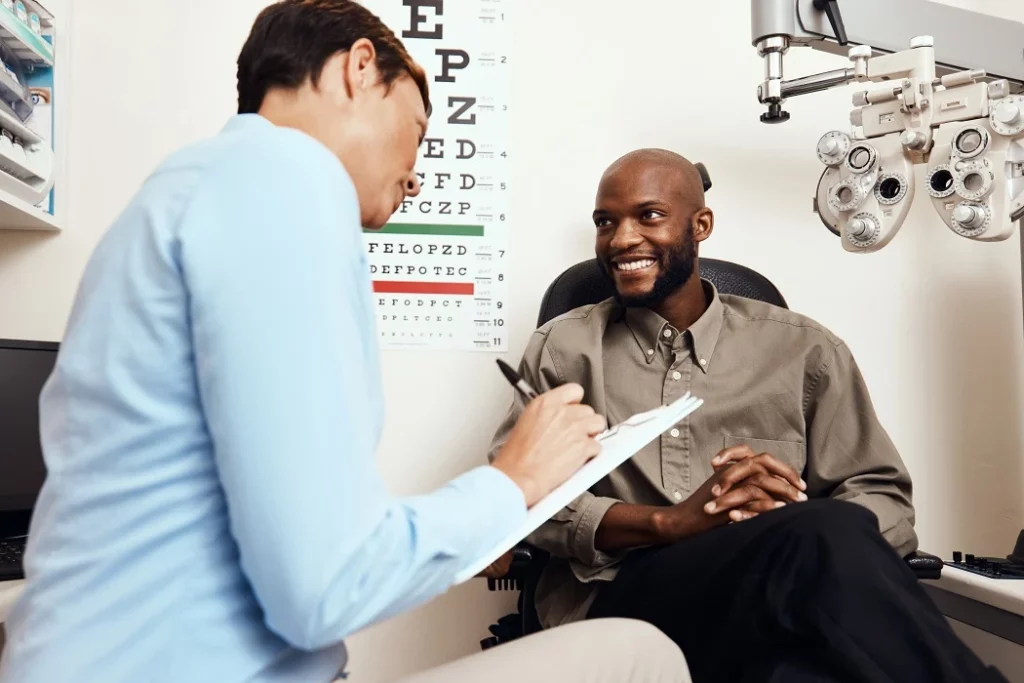Take A Look At the Best Optometrist Riverside for Comprehensive Eye Treatment
Take A Look At the Best Optometrist Riverside for Comprehensive Eye Treatment
Blog Article
The Comprehensive Eye Exam: What to Anticipate During Your Visit to the Eye Doctor
A browse through to the eye doctor for a detailed eye exam is more than a routine exam; it is a crucial action in protecting your visual health and wellness. From the initial conversation of your medical background to the accuracy of the visual skill test, each component of the exam serves a details objective. What exactly takes place throughout the eye health and wellness assessment, and how does it influence the prescription process? Recognizing these aspects is essential for those that desire to keep optimum eyesight. As we discover each part, the importance of follow-up referrals will additionally become clear.
First Consultation
The initial appointment throughout an eye exam acts as a crucial foundation for understanding a patient's visual health requirements. This phase sets the tone for the entire evaluation process, allowing the optometrist to collect vital details regarding the patient's medical background, way of life, and details vision concerns. By thoroughly evaluating any type of pre-existing conditions, drugs, or previous surgical procedures, the eye treatment expert can tailor the examination to address specific needs effectively.

Additionally, the initial assessment is a possibility for individuals to voice any concerns or questions, promoting a joint relationship with their doctor. This communication not just ensures that the person really feels informed and comfy yet also equips them to take part proactively in their eye health management. Collectively, these conversations allow the optometrist to create a tailored examination plan, ensuring ideal care and specific medical diagnosis.
Aesthetic Skill Examination
Beginning the core parts of an eye examination, the visual skill examination is designed to analyze the intensity and clarity of an individual's vision. This critical evaluation aids establish exactly how well an individual can recognize letters or signs at a standardized range, commonly making use of a Snellen chart (Optometrist Riverside). The chart consists of rows of letters that lower in dimension from top to bottom, with the patient placed at a popular distance of 20 feet
During the test, the person is asked to cover one eye and review aloud the smallest line of letters they can see clearly. This process is repeated for the various other eye. The results are taped as a fraction, with 20/20 vision suggesting regular aesthetic acuity-- where the individual can see at 20 feet what a person with normal vision can see at that range.
The aesthetic acuity examination additionally identifies potential refractive errors such as astigmatism, myopia, or hyperopia, which may demand restorative lenses. By establishing a baseline of aesthetic efficiency, the examination is an essential analysis tool that assists the eye treatment specialist in establishing a suitable therapy strategy tailored to the person's unique visual demands.
Eye Health And Wellness Assessment
Adhering to the visual skill examination, a detailed eye wellness analysis is conducted to make sure the general well-being of the eyes. This essential section of the eye examination involves a complete assessment of both the interior and exterior structures of the eye. The ophthalmologist or eye doctor starts by analyzing the eyelids, cornea, conjunctiva, and sclera for any kind of indicators of infection, swelling, or irregularities. Making use of specific equipment like a slit lamp, the practitioner gains a magnified sight of the eye's makeup, enabling in-depth examination.
Following, attention shifts to the inner frameworks. Via the use of ophthalmoscopy or fundus photography, the retina, optic nerve, and blood vessels are diligently assessed. This step is vital for identifying conditions such as retinal detachment, glaucoma, or diabetic person retinopathy. In most cases, student dilation is executed to enhance Website visibility of the internal eye frameworks, although this might result in short-lived light level of sensitivity for the person.
Additionally, intraocular stress is determined to evaluate for glaucoma risk. This is typically done using tonometry, which can detect raised pressure levels that could recommend possible damages to the optic nerve. Jointly, these evaluations develop a detailed evaluation to keep ocular wellness.
Refraction and Prescription
Refraction is an advanced procedure carried out by eye care specialists to identify the precise lens power needed to correct refractive mistakes such as nearsightedness, presbyopia, hyperopia, and astigmatism. The objective of this treatment is to analyze just how light bends as it passes through the eye, permitting the professional to determine whether restorative lenses are necessary for enhanced visual acuity.
Throughout the refraction procedure, the individual is asked to look with a phoropter, a gadget that includes numerous lenses. The professional will systematically alter these lenses and ask the person to contrast clarity between choices up until the very best possible vision is accomplished. This treatment is crucial in crafting an exact prescription that defines the ideal lens power for spectacles or get in touch with lenses.
The prescription acquired from this procedure not just optimizes vision yet also serves as a foundation for selecting ideal corrective eyeglasses. It is important to make certain that prescriptions are routinely upgraded, as changes redirected here in vision can take place in time, stressing the value of regular eye exams. This precise focus to detail assists maintain clear, comfortable vision in daily life.
Follow-Up Suggestions

Throughout a follow-up visit, the eye medical professional will carry out a collection of examinations to assess aesthetic acuity and check for any changes in vision that might demand an update to the prescription. Furthermore, the follow-up offers a possibility to discuss any kind of discomfort or concerns experienced with current eyewear. Changes can be made to make sure comfort and efficiency, whether with lens alteration or frame modifications.
For patients with recurring problems such as glaucoma, diabetes-related eye issues, or macular deterioration, more constant follow-ups may be necessary. These visits are critical for managing and potentially slowing the progression of eye disease. Following these recommendations can considerably add to preserving aesthetic wellness and avoiding long-term complications.
Conclusion
The extensive eye exam is an important process for maintaining aesthetic wellness, including an in-depth assessment of case history and vision issues. Trick components consist of the aesthetic acuity test, which examines vision clearness, and the eye health assessment, which examines the overall condition of the eyes. Refraction examinations aid establish the specific lens prescription needed for optimum vision correction. Follow-up recommendations supply advice for ongoing eye treatment, making certain that any type of potential issues are addressed without delay and successfully.
A see to the eye medical professional for an extensive eye exam is more than a regular check-up; it is an important action in guarding your aesthetic health and wellness.Kicking off the core parts of an eye exam, the visual skill examination is developed to evaluate the intensity and clarity of a patient's vision.Adhering to the aesthetic acuity examination, navigate here a thorough eye health and wellness analysis is conducted to make sure the overall wellness of the eyes. These sees enable the eye care professional to keep an eye on adjustments in vision, upgrade prescriptions, and evaluate the overall wellness of the eyes. Key parts consist of the aesthetic skill test, which examines eyesight clearness, and the eye health assessment, which examines the total problem of the eyes.
Report this page